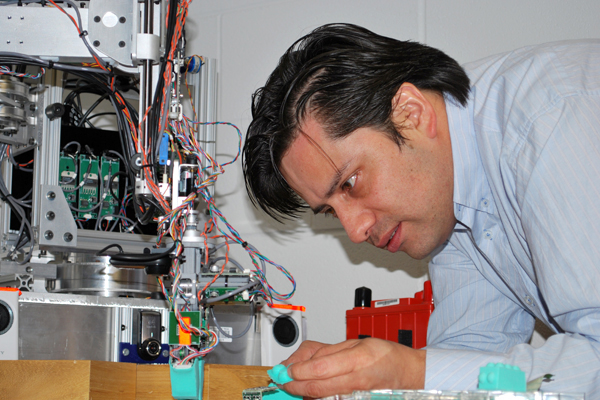At Worcester Polytechnic Institute, Eduardo Torres-Jara is working with tactile sensors and soft materials to create a robotic arm that can gently manipulate objects and be interacted with safely by humans.
His goal is to create a robot with a soft exterior and an abundance of sensors, the idea being that when you grab it gently on the arm and pull it one direction, it would sense and then follow you. In the end, it would have to be non-threatening enough to make elderly or disabled people feel safe, with the capability of adapting to situations and taking commands through physical interaction, as opposed to through a computer network and visual or infrared sensors like most robots do.

Eduardo Torres-Jara
“Take how we interacted with computers,” says Torres-Jara. “Before it was just people making holes in cards, then it moved to a keyboard and a screen, and now you have things like the iPhone and the iPad, which are very easy and intuitive to interact with. That’s also going to happen with robots. Instead of people sitting at a computer and programming them, the robots themselves will be able to get information directly from the people who are trying to train them.”
Ultimately, the goal for almost everyone in soft robotics is the same. Approach the functionality and efficiency of nature’s perfect actuators: muscles.
“The muscle is an incredibly sophisticated biological structure, and understanding how to mimic its structure and its function is just not something we know how to do,” says Whitesides. “The ability to come up with something that works like a muscle, a real muscle, with the same functions would be an enabling technology that would allow us to do all kinds of things.”
Dr. Trimmer over at Tufts sees a different, more radical path for soft robotics. “I was scratching my head and thought to myself, ‘Why are we using artificial muscles? Why don’t we just use muscles?'”
His idea is to eventually grow muscle cells and control them with an implanted chip. While the idea of a robot made of flesh might be unsettling for some, Trimmer claims the lack of a nervous or reproductive system makes it no different from, say, the meat being grown in a lab by scientists in the Netherlands.
No matter what the field of soft robotics looks like in 10 or 20 years, one thing’s for sure: The days of thinking of robots solely as stiff, mechanical creations are over forever.

